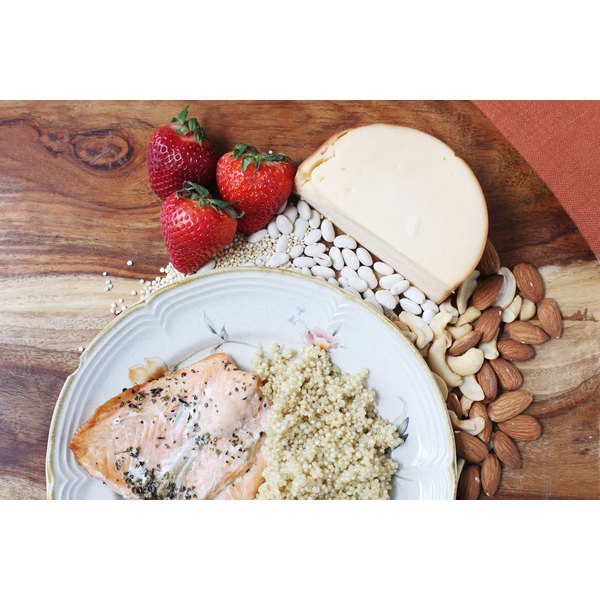
Moderately increasing your protein intake could help you shed pounds, according to an article published in The American Journal of Clinical Nutrition in May 2008. Protein is the most satiating nutrient -- more than carbohydrate and fat -- so it can help you stay satisfied while you reduce your calories, and it helps you retain lean muscle mass during weight loss. If your goal is to gain muscle mass, increasing your protein intake along with regular weight training is an effective strategy. The key is to make sure your protein is coming from healthy sources.
How Much Protein You Need
Daily protein targets for adults are given both in grams and as a percentage of calories. The recommended daily intake for protein for men between the ages of 19 and 50 is 56 grams, and for women in the same age group it's 46 grams. This is based on an estimated 0.8 gram per pound of body weight.
The acceptable macronutrient distribution range is 10 to 35 percent of calories. The latter measure is a better tool to use to figure out your protein needs on a high-protein diet. You should aim for the high end of the scale.
If you eat a typical 1,800-calorie diet, you'll need about 113 to 158 grams of protein per day. You shouldn't go above 35 percent of your calories from protein because too much protein poses health risks including dehydration, calcium loss and kidney problems.
Protein Types and Sources
Protein primarily comes from animal products such as chicken, fish, beef, pork and lamb. Milk, cheese and yogurt are also rich sources of protein. Many plant foods are rich sources of protein, too, including beans, peas, nuts, seeds and some grains. The protein in animal foods is complete, which means it contains all the amino acids -- the building blocks of protein -- your body needs to repair, maintain and build new muscle and support other physiological functions. Soy and quinoa are the only plant sources of complete protein; all other plant foods provide incomplete protein, which means they are missing or low in one or more of the amino acids. However, if you eat a variety of plant proteins during the day, your body can put together what it needs from different sources.
Try These Breakfast Meals
Eggs are a top source of protein at breakfast. Mix one egg with a couple of egg whites, some veggies and an ounce of cheddar cheese for a meal that packs in almost 22 grams of protein. Serve it with a cup of low-fat cottage cheese topped with fresh berries for another whopping 28 grams of protein. Pile your plate with protein pancakes for a sweeter approach to breakfast. Registered dietitian Joy Bauer's recipe for protein pancakes calls for 1/2 cup of rolled oats, four egg whites, a little sugar and a little cinnamon. Each serving offers 20 grams of appetite-satiating protein.
Pack a Protein Punch at Lunch
Take your pick of high-protein lunch sandwiches piled high with veggies on whole-grain bread. Tuna fish salad, egg salad, roast chicken, turkey and baked salmon are all delicious, high-protein sandwich fillings. Try a tuna melt made with 3 ounces of light tuna in water with a slice of cheddar cheese on top for about 24 grams of protein. If you crave a big salad, load it with high-protein veggies such as beans, spinach and broccoli. A salad made with 4 cups of raw spinach, 1/2 cup of garbanzo beans and a cup of chopped broccoli has almost 14 grams of protein. Add an ounce of pumpkin seeds for another 5 grams of protein and some healthy fats.
Dig Into These Dinners
High-protein dinners are a snap when you have so many choices. Three ounces of wild Atlantic salmon provides 17 grams of protein, a 3-ounce skinless grilled chicken breast provides 26 grams of protein and a burger made with 3 ounces of 97 percent lean meat contains 22 grams of protein. Serve your fish, chicken or beef with 1/2 cup of quinoa for another 4 grams of protein and 1/2 cup of black beans for another 8 grams of protein.
For a meatless meal, try slices of baked tofu drizzled with olive oil, lemon and black pepper. Each 3-ounce serving contains 8 grams of protein. Pair it with a quinoa-and-black-bean salad and sauteed spinach. Have a container of Greek yogurt with fruit for a dessert worth over 17 grams of protein.
Original article and pictures take healthfully.com site
Комментариев нет:
Отправить комментарий